Essence: Walk through two slim canyons that have excavated passageways through the San Rafael Reef. Some corridors are straight and long, others sinuous. Pass between colorful tapestries interweaving a remarkable tafoni texture and water-polished smoothness. The clockwise loop includes an optional road section; Crack Canyon, beautiful all the way through with three stretches of narrows; a fast overland trek across the San Rafael Desert; and a stroll up obstacle-free Chute Canyon. Hiking is mellow except for two Class 3 downclimbs in Crack. The region is administered by the BLM. Most of the hike is within the 26,000-acre Crack Canyon Wilderness Study Area. No bikes, no vehicles.
Travel: From I-70, Exit 149, drive south on UT-24 for 24 miles. From Hanksville, drive 19 miles north on UT-24. Turn west on Temple Mountain Road following the sign for Goblin Valley State Park and measure distance from there. At 5.0 miles continue straight where the road to Goblin Valley heads south. Pass the South Temple Wash Campground and enter the Muddy Creek Wilderness. The road turns to dirt at 6.2 miles. Pass the Temple Mountain Townsites Campground. If these campgrounds are full, there is plenty of dispersed camping further along the route. Turn left on Behind the
Reef Road at 7.1 miles. Sturdy tires and moderate clearance are necessary to reach the Crack Canyon Trailhead at 11.1 miles (on the left). To run a shuttle or walk the entire circuit, the Chute Canyon Trailhead is another 2.3 miles. The road between Crack and Chute is comparable. Cross into Little Ocean Draw Wilderness at 11.4 miles. Cross the sandy Chute Canyon wash at 12.9 miles. Park at the signed Chute Canyon Trailhead at 13.4 miles. The dispersed camp across from the trailhead was a shaded ice box in April. No water or facilities at either trailhead.
Distance and Elevation Gain: 10.5 miles with 500 feet of vertical for Crack, the overland route, and Chute. The road from Chute to Crack adds 2.3 miles and 500 feet.
Total Time: 5:00 to 7:00 for the complete circuit
Difficulty: Jeep road, canyon floor, trail; navigation moderate; Class 2 except for the Class 3 drops in Crack; no exposure; significant flash flood hazard; seasonal pools. Carry all the water you will need and hike on a cool day.
Maps: Temple Mountain; Goblin Valley; Little Wild Horse Mesa; Horse Valley, Utah 7.5' USGS Quads
Latest Date Hiked: April 29, 2022
Geology: The San Rafael Swell is located in the northwest quadrant of the Colorado Plateau.
The Swell is a dome-like upwarp or anticline formed about 65 million
years ago and measuring 75 miles long and roughly 30 miles wide.
Tectonic forces
buckled sedimentary layers into the
broad fold. The upwarp is gently
inclined on the west but the rocks on the eastern edge are tilted up on
end in a monocline, the San Rafael Reef. With relatively little
elevation change, the hike down Crack Canyon passes through successively
younger classic formations associated with the Colorado Plateau. The
easily eroded, colorful Chinle Formation underlies
sheer-walled Wingate Sandstone. Ledge-forming Kayenta Formation is
overlain by beige, Navajo Sandstone domes and towers. The tour of rocks is
reversed on the return up Chute Canyon.
Haiku:
Days of thunder pass,
Sweep a lace of stone and void,
Night blooms Datura.
Sweep a lace of stone and void,
Night blooms Datura.
--Thomas Holt Ward
Hikers transition from the eternal shadow of storm-carved depths into luminosity in ethereal Crack Canyon. (Chris Blackshear, photo)
Route: The circuit is typically run clockwise to mitigate the challenges in Crack Canyon. Minus a shuttle, park at the Chute Canyon Trailhead and walk generally northeast on Behind the Reef Road to the Crack Canyon Trailhead. Walk south-southeast until the canyon walls recede. Hike southwest across the San Rafael Desert and drop into Chute Canyon. Hike north in Chute, closing the loop at the trailhead.
Chute Trailhead (elevation 5,140 feet) to Crack Canyon Trailhead
For hikers without a shuttle, the stretch between the trailheads is 2.3 miles with 500 feet of uphill and takes 45 minutes to an hour. It is a good call to get this segment out of the way
first thing. Traffic is negligible early
in the morning and sunshine gathers in Crack Canyon while you are walking. Below, early light accentuates whimsical Wingate towers holding down the Chinle Formation.
Behind the Reef Road has long strips of scraped bedrock. I've included this photo so drivers have a sense of whether their vehicle is up to the task.
Leave the Little Ocean Draw Wilderness. Chute Benchmark, 6,508' ("Chute Buttress"), emits a strong presence.
Crack Canyon Trailhead (elevation 5,480 feet) to Canyon Exit
This segment of the loop is about 3.8 miles with 480 feet of elevation loss. Weekdays are quiet; weekends, busy. Word is out about one of the sweetest canyons in existence. Start out on a two-track heading south toward a yawning gap in the San Rafael Reef.
At 0.5 mile, leave the road in favor of the canyon floor. Downclimb or bypass the first minor obstacle down-canyon right.
Cross the contact between the Chinle Formation and Wingate Sandstone. Walls immediately soar 400 feet overhead. Light casts a double reflection. The wall in shadow is illuminated by sun reflecting off the opposite wall.
(Thomas Holt Ward, photo)
Wingate Sandstone is one of the "big three" formations comprising the Glen Canyon Group. Wingate, Kayenta Formation, and Navajo Sandstone are viewed from a broader and even finer perspective on the Waterpocket Fold in nearby Capitol Reef National Park. Cliff-forming Wingate is red-orange with streaks of desert varnish.
In Crack Canyon, Wingate Sandstone has composed a veritable symphony of extraordinary tafoni. The polygenetic origin of the connected networks is poorly understood but is thought to result from a complex interaction of physical and chemical weathering
processes. Tafoni develops in a wide range of rock types. In the Wingate, acidity in rainwater dissolves calcite, the bonding agent of sandstone, thereby creating and enlarging the cavities. The tafoni madness one mile into the hike is as good as it gets on the Colorado Plateau. (THW, photo)
Flash floods deposit pebbles and larger debris in the cavities. This highly textured wall in upper Crack is a source of amusement for hikers of all ages. It is just the beginning of an exquisite array of tafoni throughout both Crack and Chute canyons.
Over the coming miles, the canyon opens and constricts repeatedly. The first set of narrows at 1.2 miles begins with an entrance tunnel. (THW, photo)
A testimony to the power of water, the ceiling is undercut and overhung, the floor and walls sculpted. (THW, photo)
The canyon is ceaselessly mesmerizing. Forms are exquisite and varied, the surrounds are quiet and peaceful, even sensual. (THW, photo)
The geological formations on the monocline tilt up to meet the hiker. Though we've descended minimally, below I am walking through the ledge-forming Kayenta Formation. This is the rock that creates all the Class 3 excitement in Crack Canyon. (THW, photo)
By definition, a slot is so tight the average human can touch opposite walls with hands outstretched. Crack doesn't meet that standard but it constricts into a pseudo slot at 1.7 miles. The first Class 3 downclimb is a triple-tiered drop at about two miles. The eight-footer is made more challenging because the boulders serving as holds are rounded and smooth. Some hikers will need a spot. The drops commit you to the full loop unless you are skilled with up-climbing.
(THW, photo)
This image looks back on the pitch. The next two moves in the series are inconsequential unless they are pooled; be prepared to wade after rain.
Stone reaches out to embrace a passer by. (Chris Blackshear, photo)
Walls and towers strain to close the gap between them. (THW, photo)
Some will find the second Class 3 obstacle more difficult than the first. We braced off the walls to negotiate the ten-foot drop.
Walls are subtly overhung in this tunnel-like segment. Sun gleams on a few lucky spots when days are long. Fluted walls, gravel floor--idyllic. (THW, photo)
Upon entering Navajo Sandstone the canyon widens. Micro fractures in the formation have created one rounded dome after another. The whole scene reminds me of Bell Canyon which pierces the monocline five miles west as the crow flies.
Utah-blue sky predominates as the canyon punches through the east side of the Reef. There is a side canyon on the right 0.15 mile before the exit route. (THW, photo)
Overland Trail Across the San Rafael Desert
A sign at 5,000 feet in elevation directs to Chute Canyon. The overland route is 2.3 miles with 160 feet of climbing and takes about one hour. The trail cranks 180 degrees and lifts off the canyon floor.
The footpath bears southwest across the face of the Southern Reef. It is well-established for the most part but braided in places. If you find yourself on a loose end, retreat and locate the main track. The immediate landscape isn't super appealing but the long-range vista is outstanding. In 2022, the persistent drought in the West coupled with relentless wind created a dust-laden haze. Even so, we could see Goblin Valley and the Henry Mountains. The wide-open traverse puts the two canyons in context. (THW, photo)
Come alongside a tributary of Chute at 4.7 miles. A cairn marks an alternate route down into the tributary. We stayed on top until we were 2.2 miles into the overland route. The trail was vague right where you need to drop into Chute Canyon. Descend a sandy hillside and arrive on the canyon floor at 6.1 miles, 4,820 feet.
Lower Chute Canyon to Chute Trailhead
The trek through Chute Canyon is 4.4 miles with 320 feet of rise. Head north upcanyon. In just 0.3 mile the corridor constricts to 20 feet and barrels up a long straightaway with a uniform gravel floor.
The canyon becomes sinuous, meandering lazily. I felt as if I was inside a caldron of gold. (THW, photo)
Bulbous walls soar overhead. Navajo Sandstone looks like a pot of boiling stone, folded and irregular.
Elephant skin on the Kayenta Formation gives it a living presence in this hiking theater. (THW, photo)
The canyon widens and the Kayenta presents in chaotic disarray. Blocks are poised to give way but the jumbled mass holds together somehow, at least in this moment.
Delicate lace tafoni on vertically-walled Wingate Sandstone supplants disordered Kayenta. (THW, photo)
Chute swings past a major amphitheater. Below, the Wingate overlies purple Chinle Formation in this tilted world. Leave the Crack Canyon Wilderness Study Area 1.25 miles from the trailhead. Finish on a 4WD track.
This daring leap in Crack Canyon was captured by friend and photographer, Chris Blackshear.







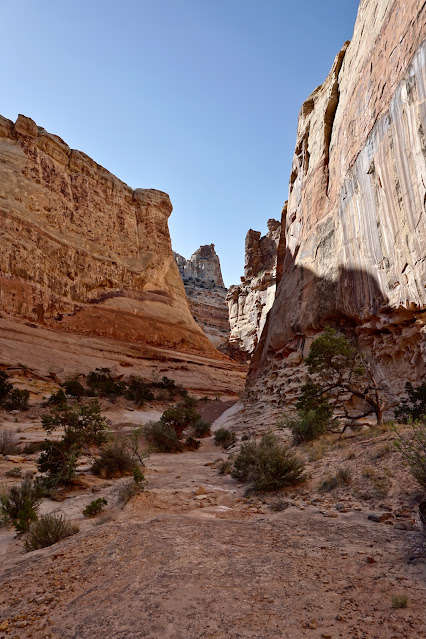




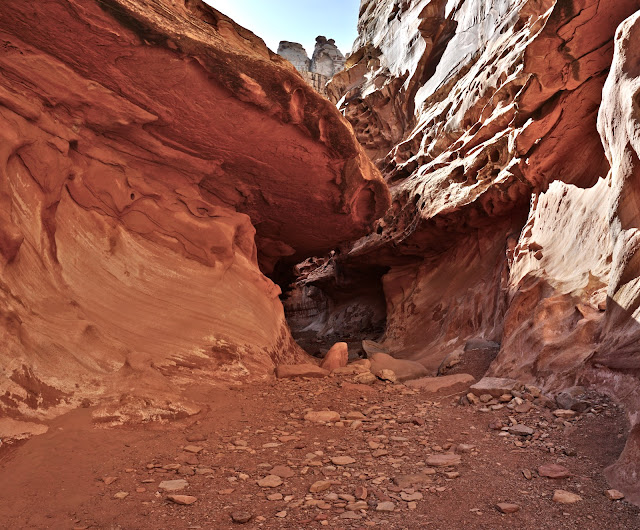














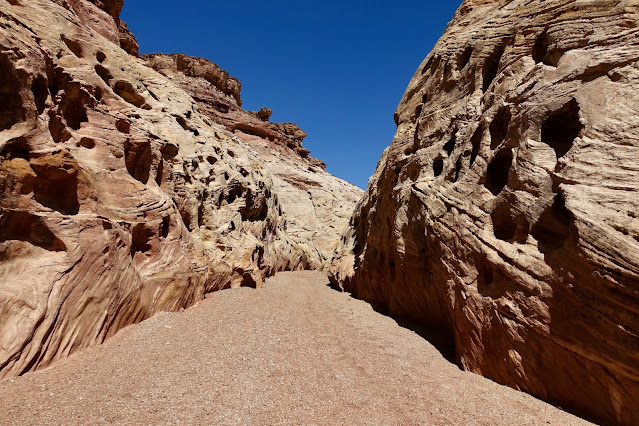



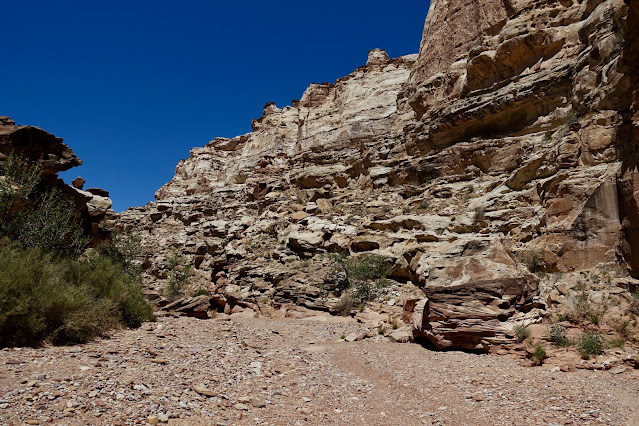







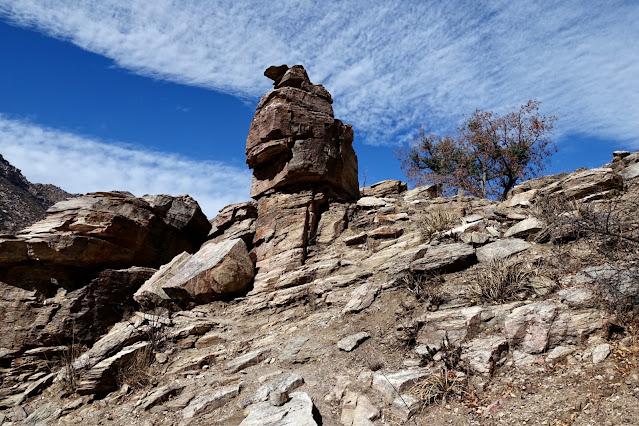














.jpeg)







